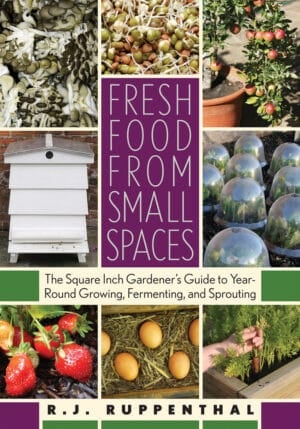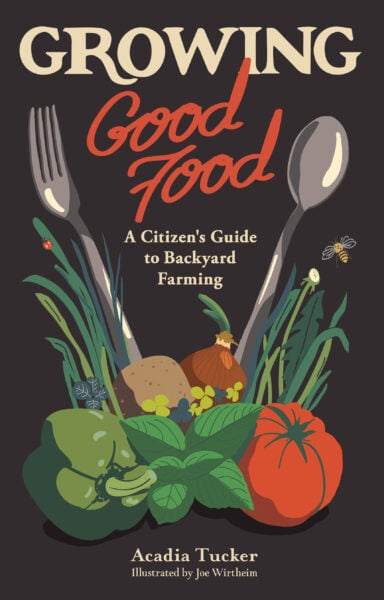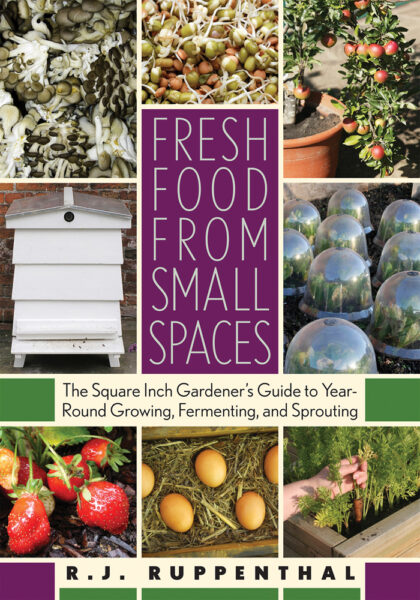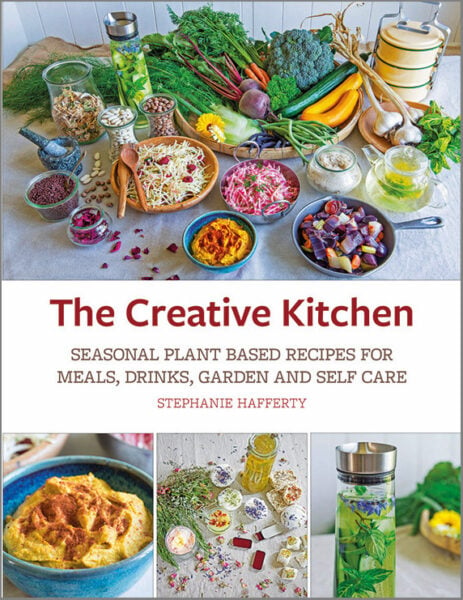Sprout Today, Eat Healthy Tomorrow
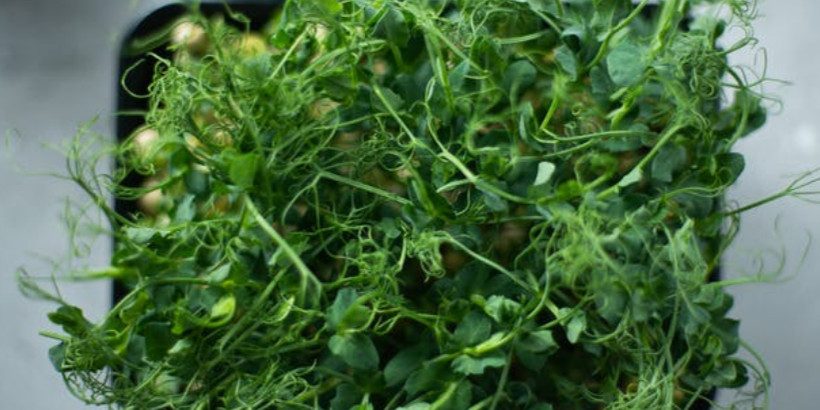
If you’re ready to start growing a portion of your own food, but you aren’t quite ready for something that requires a big time commitment or a lot of effort, this is a good place to start. Sprouts are easy to cultivate, mature very quickly, can be used in a variety of delicious dishes, and really pack a nutritional punch.
The following is an excerpt from Fresh Food from Small Spaces: The Square-Inch Gardener’s Guide to Year-Round Growing, Fermenting, and Sprouting by R. J. Ruppenthal. It has been adapted for the Web.
I have a confession to make. Early in the book, I make a claim that city residents with an average-sized apartment or condominium can raise up to 10 to 20 percent of their own fresh food. This, I confess, was a lie. You can actually grow an even higher percentage of your own fresh food, depending on what percentage of your diet can consist of fresh sprouts! There is an old saying that “man does not live by bread alone.” This is probably true of sprouts also, especially given that you would get weary of eating nothing but sprouts day in and day out (even though, nutritionally, you might meet most of your dietary needs this way). My point is this: If you wanted to grow enough sprouts to live on, using the space in your apartment or condo, you could probably do so. There is simply no other food that you can produce so much of, in so small a space, so quickly, and with such a potent nutritional output. With sprouts, the limiting factor is not space, or light, or soil, or even water. The limiting factor is: How many sprouts can you really eat?
How difficult is sprouting and how much time does it take?
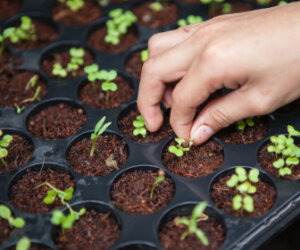 Sprouts can grow with no soil or light, and they will be ready within 4 to 10 days, depending on what kind of seeds you sprout. So, basically, the process itself is very quick and you can produce fresh vegetables in just days instead of months. In terms of your time commitment, it will require a few minutes each day to rinse the sprouts to prevent mold.
Sprouts can grow with no soil or light, and they will be ready within 4 to 10 days, depending on what kind of seeds you sprout. So, basically, the process itself is very quick and you can produce fresh vegetables in just days instead of months. In terms of your time commitment, it will require a few minutes each day to rinse the sprouts to prevent mold.
If you decide to invest in an automatic sprouting system, then this will keep your sprouts well rinsed; you will just need to change the water every day or so to keep it fresh. Home sprouting in your own controlled environment allows you to avoid contamination risks associated with commercially-grown sprouts.
In terms of equipment, you can either start with what you have at home or purchase a more specialized sprouting device. To use readily available materials and save money, you can start with either a glass jar or a plastic seedling tray. A cloth bag that is wet, warm, and filled with bean seeds also can work if you rinse it regularly. Regardless of what kind of equipment you use, all of it should be well washed beforehand and you should plan to rinse your sprouts about three times per day as they grow. (It will take less than one minute each time.)
A glass jar is by far the easiest way to experiment with sprouting seeds. To sprout in a glass jar, you will need to cover it with something that can hold in the seeds when you rinse them. A screen held on with a rubber band should work well. First, put a handful of the seeds you want to sprout (alfalfa, mung beans, etc.) in the bottom of the jar. Fill the jar part way with cool water, and allow the seeds to soak for about 8 hours. Then pour out the water through the screen and refill it with enough water to rinse the seeds. Repeat the rinsing part again, and try to drain out as much of the water as possible. Leave the seeds to sprout and return to rinse them this way about three times each day. In only a few days, you should have some yummy sprouts!

Growing on a seedling tray requires that you use some type of growing medium that mimics soil. Actually, there is no rule against using soil itself, which can provide both support and a little nutrition to the sprouts. Stick to the sterilized soil, or put some in the microwave and cook on high power for two minutes to kill any pathogens. Other soilless mediums for sprouting can include perlite or asbestos-free vermiculite, which may be available at your local garden center.
Theoretically, you can use a wet paper towel or sponge as a base, but the sprouts won’t be able to get any traction this way and thus will be very weak.
Finally, it’s helpful to cover the tray with something, which could be another plastic tray or a cutting board—anything flat that can help keep it from drying out. Otherwise, follow the same basic instructions as the glass jar method for soaking and rinsing. You also can rinse seedling-tray sprouts by spraying them regularly with a spray bottle and dumping out the excess water from the edges. Wheatgrass, which takes a few days longer than eating sprouts, will require some extra nutrition to grow to its full potential. The best growing supplement for any of these methods is kelp extract. Dilute it to a very low strength and spray it on the sprouts to increase their rate of growth and nutritional value.
What can you grow into sprouts?
Here is an incomplete list.
GRAINS: wheat, barley, rye, popcorn, quinoa, and others.
LEGUMES: lentils, peas, adzuki beans, black beans, garbanzo beans, mung beans, soybeans, and others.
GREENS: alfalfa, broccoli, clover, canola, radish, buckwheat, sunflower, and others.
OTHERS: Some people sprout nuts such as almonds and peanuts, micro-greens such as lettuce and arugula, and plants with stronger flavors such as fenugreek and onion.
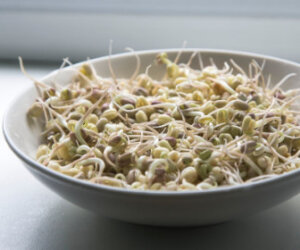 You can order seeds over the Internet from sprouting seed sources or can simply try your luck in the bulk section of your local health food store. You can mix seeds, but it is usually better to start with separate amounts of each seed type you want to grow, because some take longer to mature than others.
You can order seeds over the Internet from sprouting seed sources or can simply try your luck in the bulk section of your local health food store. You can mix seeds, but it is usually better to start with separate amounts of each seed type you want to grow, because some take longer to mature than others.
Make sure that the seeds are organic or at least untreated. If you are ordering seeds online, then look for ones that are specifically labeled as “sprouting seeds.” These should be fresh and have been tested for a high germination rate; they are not always the same seeds that would grow big plants in your garden.
Several quality online retailers are the Sprout People, with a wealth of information on their Web site; Mumm’s Sprouting Seeds; Sunrise Seeds; and Wheatgrass Kits. Also, try your local health food store’s bulk section; you might get lucky and find some good, fresh seeds. I found my best batch of sprouting soybeans this way, which were far more productive for me than any soybeans I have ordered online.
Recommended Reading
Recent Articles
Garlic mustard: while known as “invasive,” this plant can be consumed in its entirety and has great nutritional value. Plus, the garlic-flavor is a perfect addition to any recipe that calls for mustard! The following are excerpts from Beyond the War on Invasive Species by Tao Orion and The Wild Wisdom of Weeds by Katrina…
Read MoreEveryone loves a refreshing, fermented, nutritious drink…even your garden! Take your fermentation skills out of the kitchen and into the garden by brewing fermented plant juice. The following is an excerpt from The Regenerative Grower’s Guide to Garden Amendments by Nigel Palmer. It has been adapted for the web. How to Make Fermented Plant Juice Fermented…
Read MoreOh, honeysuckle…how we love thee. If only there was a way to capture the sweet essence of this plant so we could enjoy it more than just in passing. Luckily, foraging and some preparation can help make that happen! Here’s a springtime recipe that tastes exactly like honeysuckle smells. The following excerpt is from Forage,…
Read MoreWant to see your crops thrive this upcoming growing season? The key is in soil fertility and health. Spend time maintaining your soil’s health to guarantee bigger and better crops come harvest time! The following is an excerpt from No-Till Intensive Vegetable Culture by Bryan O’Hara. It has been adapted for the web. What Is Soil Fertility?…
Read MoreIntroducing…your new favorite brunch dish! This whole broccoli frittata is packed with fresh, wildcrafted flavors that are bound to help you start your day off on the right foot. The following is an excerpt from The Forager Chef’s Book of Flora by Alan Bergo. It has been adapted for the web. RECIPE: Whole Broccoli Frittata…
Read More

